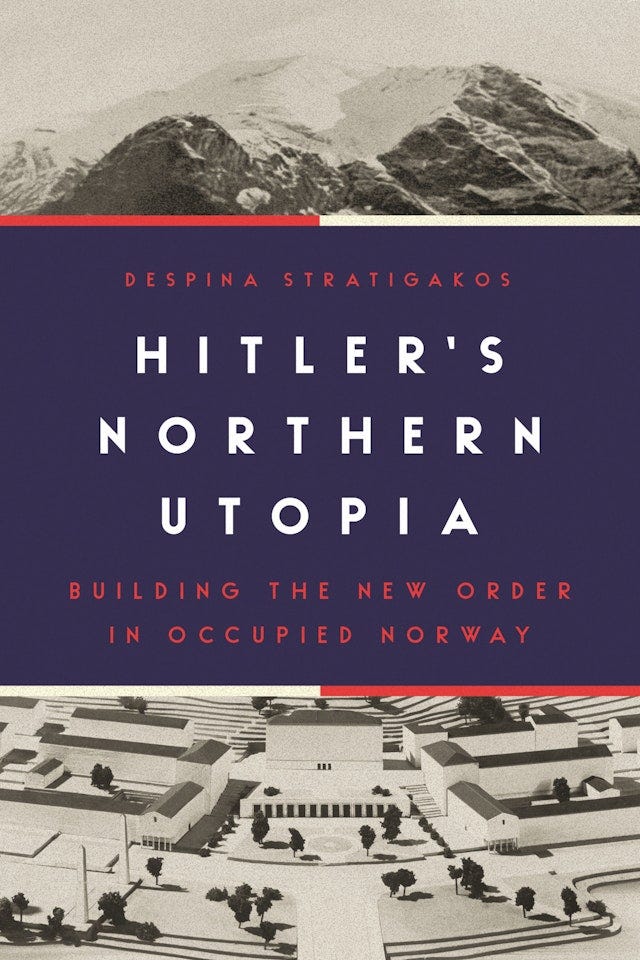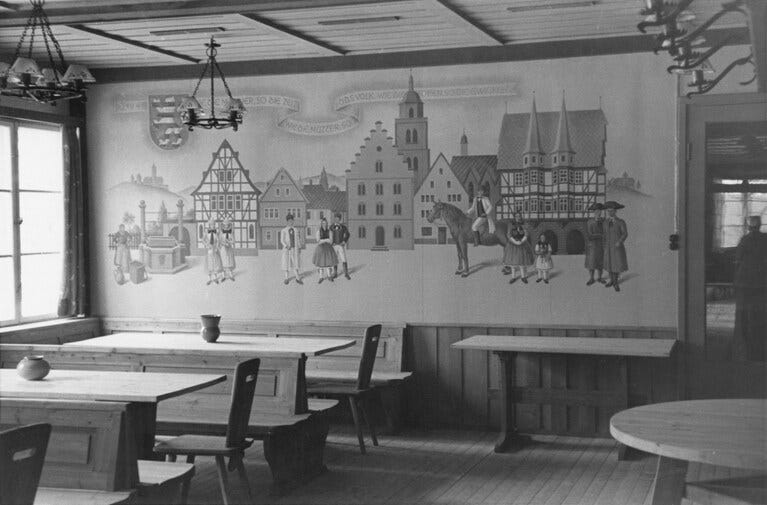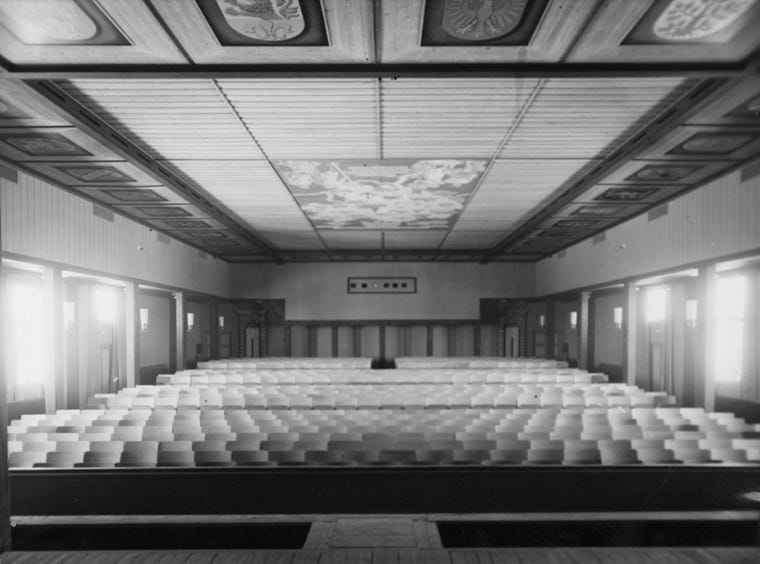Nazi plans for Norway, 1940-5
A new book examines what National Socialist Norway would have looked like and what was actually achieved under occupation.
Despina Stratigakos, Hitler’s Northern Utopia: Building the New Order in Occupied Norway, Princeton University Press, 2022, paperback, 313pp + x, mono illus., $19.95, ISBN 9780961234137
In April 1934, the newly appointed Chancellor of Germany made a surprise visit. He was on a German battleship which visited the fjords of Norway. It was not an official visit and no one, including naval officials, knew quite why he was there. Perhaps Hitler himself did not know. He seemed approachable and serious, treating ratings and officers equally courteously, admiring the scenery and pleased with the performance of crew and ship. Few could have guessed that six years later, Hitler would be de facto ruler of Norway.
Despina Stratigakos’s book Hitler’s Northern Utopia: Building the New Order in Occupied Norway, recently issued in paperback, explores exactly what the Nazis occupiers did in Norway and what they had planned. In relative terms, much of it was benign compared to what happened to other occupied lands. As with Austria, Norway was seen as Germanic and a natural part of the Reich. The military capitulation of Norway in 1940 was seen by the Nazis not as a nation admitting its military inadequacy and geographic isolation in the face of an overwhelming force, but rather as Norwegian admission of an inevitable unification of the Aryan people. The Nazis saw the future of Norway as part of a Germanic racial destiny, with a number strategic advantages for the German leaders of this group.
[Image: Lebensborn nurses]
One German race expert (Hans Friedrich Karl Günther) estimated “Norwegians possessed more than 70 to 80 percent pure Nordic blood, while Germans themselves retained only 50 to 60 percent in their veins.”[i] So, mingling of German and Norwegian genetics would lead to an over increase in the Nordic character of future generations of Germans. To that end the Lebensborn project was established, to encourage Norwegian women and German soldiers stationed in the country to have children. Hotels around the country were commandeered to house any unwed Norwegian women pregnant by German men. Norwegian orphans possessing distinguished Nordic characteristics were moved to Germany for adoption. This project was semi-secret, not publicly announced and not openly approved of by Norwegian authorities. It continued until the last month of war, even as Soviet and German troops were engaged in scorched-earth warfare in northern Norway.
[Image: German soldiers in occupied Oslo]
Settlement of Norway by Germans, who could connect with their ancestral roots in new rural colonies, were planned but (unlike Eastern Europe) this would not displace the native population and no genocide was not considered. There were plans for an extensive series of barracks and settlements; so grand were the plans that they would have required the importation of wood from Sweden. The author describes the architecture of the few buildings erected and explains the internal wrangles between Albert Speer, the Labour Front (which erected and commissioned the buildings) and Norwegian architects (centrally Sverre Pedersen). Photographs show the National Socialist style sculpture and murals adorning the soldiers’ home (barracks-cum-settlement) in Kristiansand. The subjects of the art are patriotic staples, executed in a rather lifeless monumental manner.
[Image: a mural in the Kristiansand soldiers’ house]
The architecture (Nordic, wood-based) is both traditional, functionally modern and executed with a degree of skill (carved figurines standing on a ceiling-mounted light fitting) – all befitting a pioneering showcase. The communal spaces included canteens, pub-restaurants, reading rooms, craft rooms, a billiard hall, bowling alleys and auditoria. The auditorium of the Narvik soldiers’ home was described in the German press as “the largest hall in northern Norway”. Soldiers’-home designs were typological in approach and therefore were not generally modified to reflect the landscape and were not integrated into the local town. Commenters describe these are non-places: buildings designed to shield and detach residents from their non-German surroundings and their cultural alienness.
More building was planned, as 14,000 buildings has been destroyed during the conquest of Norway – much of it collateral damage due to the burning of wooden houses in town centres. This created an opportunity for Nazis to build entire towns, starting from street layout and reaching as far as the architectural details. This revealed the Nazis inconsistency towards architecture – a reverence for Nordic authenticity but a determination to refine that into a consistent science of National Socialism that would surpass the buildings of the past. As such there was no plan to restore or reconstruct these notably Nordic settlements with similar buildings but to build anew, with modern designs and private motorcar in mind. The English garden-city movement and Le Corbusier’s functionalism influenced calculations regarding the sizes of open spaces, greenery, sunlight, distribution of amenities, distances between dwelling and provision of a road beltway in Pedersen’s plans for rebuilding Molde. The rebuilt church would no longer have such a prominent position, as this was a political issue, Speer deferred decision on this to Reichskommissar Terboven. The Nazis – like the inter-war functionalists – saw little place for houses of worship in their conurbations. Terboven confirmed that Parteihausen (German: (Nazi) party houses) would replace churches in Nazi-designed towns. Reichsbauen (German: state buildings) would act as town halls, post offices and telegraph offices, combining service and communication surveillance and censorship.
[Image: auditorium at Kristiansand soldiers’ home]
New designs would “help lead Norwegians away from the previous era’s “emphatic individualism” toward the new communal ideal.”[ii] The Volksgemeinschaft (German: community of people) reminds us of the socialistic aspects of nationalism, with “a process of social inclusion that was supported by promises of equality, economic prosperity, and symbolic recognition.”[iii] Nationalism has implicit in it a degree of socialism different from traditionalism. National Socialism of Germany is exactly the embodiment of Enlightenment humanism in scientific form, hardly different from the International Socialism of the USSR in the pre-1935 era.
Norway’s reliance on the importation of basic goods and fuel left it politically dependent on other countries and open to foreign influence. Nazis and their supporters argued that the urbanisation of Southern Norway was allowing architectural Modernism to gain a foothold, city-based “Jewish-Marxist” birth-control clinics were reducing the Norwegian birth rate and the anglicisation of the population (especially young female Norwegians) was undermining the essential Nordic character of the country. Young Norwegians were dancing the black American music, following foreign fashions and pursuing all the activities that deracinated the population now that they had escaped tradition and the oversight of their families in small villages. Afflicted by urban anomie, just as had been seen in 1920s Paris and Weimar Germany, Norwegian “swing kids” were succumbing to multi-culturalism, consumerism and hedonism.
The Germans planned for an entirely new city Nordstern, near Trondheim, which would showcase German architecture and urban planning, with Speer in personal charge of designs. It would provide a deep-water harbour for the German navy, as well as serving as a German colonial settlement, giving the naval base suitable independence from the native inhabitants. Like the ambitious Germania plan, this classified plan was never started in earnest. Demands for resources from the Eastern Front from 1941 onwards and the constant drain presented by the requirement to build coastal defences prevented meaningful implementation of civil construction. The sole exceptions were the building of a coastal autobahn and a railway to link northern settlements to the existing (very limited) railway network of the south. This railway would then be linked via occupied Denmark to Germany. The vision was of a Reich-spanning railway from Austria to the Arctic Circle.
The Germans, needing to build quickly, devised new techniques to build in the cold and dark that startled the Norwegians. The projects were given to the Todtamt, an engineering-architectural bureau charged with high-profile building projects, which also handled many of the defence installations dotted along Norway’s coast. Todtamt used prisoners of war in forced-labour camps. In Norway, most of these came from Poland, the USSR and Yugoslavia. The attrition rate among these workers was very high, due to infectious diseases, exhaustion, malnutrition, dangerous work and the harsh climate. The construction projects therefore made Norway more modern, economically productive and militarily defensible, while at the same time reducing the Slavic and Asiatic population.
Hitler’s plan for a continuous railway from Oslo to the Arctic Circle was partly prestige, partly democratising, but also a backbone for military supplies and troop movements. The motive given to top level German officials was to allow land transport for ore to foundries in Southern Norway or Germany, yet anyone who examined the economics of the project could see that sea transport was more efficient. Even in the last year of the war, as the Allies encroached on multiple fronts, Hitler was fixated on this hugely expensive and demanding project.
Interestingly, aesthetics were an important consideration for Todtamt and their Norwegian colleagues. Although the bridges, roads and railways were to be functional and modern, using steel and concrete, vistas were to be considered. Despite extra cost and danger, the more dramatic views were always preferred when routes were planned. The excitement of travel through a wild landscape was a component of the project and (in some respects) one of its purposes. Hitler spoke of German citizens being able to drive north on autobahns and experience the remarkable scenery. Stratigakos notes that due to military priorities and the late development of the Volkswagen, few ordinary citizens got to experience the pleasure of driving on the German autobahns. In 1935, private car ownership among Germans was 16 per 1,000 persons; in the USA it was at 204 persons.
Stratigakos’s book draws upon much research and original sources, with over 60 pages of footnotes and bibliography. Plentiful illustrations, many taken from contemporary German-language periodicals covering occupied Norway, help us understand the few concrete achievements of the period. Most of these buildings were lost in the last months of the war and the few surviving have since been demolished or converted. The book provides a thorough and informed appraisal of what was done and what might have been done in occupied Norway and provides a case study in totalitarian town planning and civic aesthetics.
[i] P. 14
[ii] P. 130
[iii] P. 130







